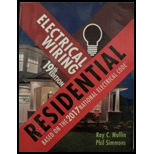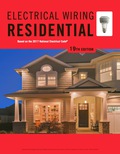
ELECTRICAL WIRING:RESIDENT.-TEXT (PB)
19th Edition
ISBN: 9781337116213
Author: MULLIN
Publisher: CENGAGE L
expand_more
expand_more
format_list_bulleted
Concept explainers
Textbook Question
Chapter 3, Problem 2R
How are branch circuits rated? See NEC 210.3._____
Expert Solution & Answer
Trending nowThis is a popular solution!

Students have asked these similar questions
ASSIGNMENT NO. 6
1. Consider the circuit below with C = 0.02 uF, Ri
100 kr
and Rf = 470 k2. The input waveform has T = 0.5 ms
and Vp = 8 V. Under steady state conditions, determine
the peak-to-peak value of the output voltage.
An RLC circuit is build with a 250 microfarad capacitor 10 mH inductor an a 15 ohms resistance in series. It isoperated with a Voltage source of Frequency of 400HZ and maximum voltage 12V. Find the angular frequency of thesource. Find the reactance of each circuit element. Find the impedance and the peak current. Find the phase factortheta between the current and the voltage source. Write the current and voltage of the circuit as a function of time.Draw an approximate V vs t and I vs t diagram. Find the resonance frequency
The project conditions are:The project functionality will be provided as per the project description suppliedbelow.You must present/demonstrate the project as a group, at the given time,andwithin a given time limit ( 20 mins ).A soft copy of all project documents is required before you
The program functionality should be as follows:• Upon entering the “run” mode all counters/timers must be reset (use the first scan bit).• When students scan RFID cards, the opening motor automatically opens the door and closing motor closes it after a 5 second wait.• The current number of students should be counted by incrementing/decrementing as students enter or leave the classroom. • The number of students entering the classroom is counted using a reflective sensor, while the number leaving is counted using a fiber optic sensor. The count should be displayed in the decimal tag "Total no of students”.• The maximum number of students in the classroom is 20, and when the classroom is occupied by the…
Chapter 3 Solutions
ELECTRICAL WIRING:RESIDENT.-TEXT (PB)
Ch. 3 - Prob. 1RCh. 3 - How are branch circuits rated? See NEC 210.3._____Ch. 3 - Prob. 3RCh. 3 - Prob. 4RCh. 3 - What spaces are not included in the floor area...Ch. 3 - What is the unit load per square foot for dwelling...Ch. 3 - According to NEC 210.50(C), a laundry equipment...Ch. 3 - How is the total load in volt-amperes for lighting...Ch. 3 - How is the total lighting load in amperes...Ch. 3 - How is the required number of branch circuits...
Ch. 3 - What is the minimum number of 15-ampere lighting...Ch. 3 - How many lighting branch circuits are provided in...Ch. 3 - Prob. 13RCh. 3 - How is the load determined for outlets supplying...Ch. 3 - What type of circuits must be provided for...Ch. 3 - Prob. 16RCh. 3 - In a single-family dwelling, how is overcurrent...Ch. 3 - Prob. 18RCh. 3 - The minimum number of outdoor receptacles for a...Ch. 3 - The Code indicates the rooms in a dwelling that...Ch. 3 - Prob. 21RCh. 3 - Prob. 22RCh. 3 - Prob. 23RCh. 3 - Prob. 24RCh. 3 - Prob. 25RCh. 3 - Although the Code contains many exceptions to the...Ch. 3 - The rating of a branch circuit is based on (Circle...Ch. 3 - a. A 25-ampere branch-circuit conductor is derated...Ch. 3 - Prob. 29RCh. 3 - Prob. 30RCh. 3 - Prob. 31RCh. 3 - Prob. 32RCh. 3 - A split-level home has one stairway that has six...Ch. 3 - Prob. 34RCh. 3 - Prob. 35RCh. 3 - Prob. 36RCh. 3 - In the past, it was common practice to connect the...Ch. 3 - If a residence has two bathrooms, the Code states:...Ch. 3 - Prob. 39RCh. 3 - Prob. 40RCh. 3 - Prob. 41RCh. 3 - Prob. 42RCh. 3 - Prob. 43R
Knowledge Booster
Learn more about
Need a deep-dive on the concept behind this application? Look no further. Learn more about this topic, electrical-engineering and related others by exploring similar questions and additional content below.Similar questions
- Solve this problem and show all of the workarrow_forwardI need help with this problem and an step by step explanation of the solution from the image described below. (Introduction to Signals and Systems)arrow_forwardI need help with this problem and an step by step explanation of the solution from the image described below. (Introduction to Signals and Systems)arrow_forward
- I need help with this problem and an step by step explanation of the solution from the image described below. (Introduction to Signals and Systems)arrow_forwardI need help with this problem and an step by step explanation of the solution from the image described below. (Introduction to Signals and Systems)arrow_forwardI need help with this problem and an step by step explanation of the solution from the image described below. (Introduction to Signals and Systems)arrow_forward
- 2) Design the circuit shown in Figure 2 to provide bias current of IQ2= 150 uA. Assume circuit parameters of IREF2 = 250 UA, V+ = 3 V, and V = -3 V. The transistor parameters are VTP = -0.6 V, λ = 0, K'p= 40 uA/V², W/Lc = 15 and W/LA = 25. V+ Mc + VSGC VSGB + MB VSGA + + MA VSDA IREF2 V- Figure 2 ww RD=8kQarrow_forward٣/١ a い يكا +91- PU + 96852 A. For the RL-circuit with i(0)=0, Find the current i(t) using LT R=2 V(t)=sin3t L=1H B. Find Invers Laplace Transform for Z(s) = = 220125 750 x2.01 4s2 +2s+3 s2-3s+2arrow_forward1) Taking base current into account, determine the value of I copy in each circuit depicted in Fig 1. Normalize the error to nominal value of Icopy. REF Vcc AE Vcc QREF Figure 1- a I copy 5AE REF 12 Q₁ copy Q2 5AE 2AE ЗАЕ QREF Figure 1-barrow_forward
arrow_back_ios
SEE MORE QUESTIONS
arrow_forward_ios
Recommended textbooks for you
 EBK ELECTRICAL WIRING RESIDENTIALElectrical EngineeringISBN:9781337516549Author:SimmonsPublisher:CENGAGE LEARNING - CONSIGNMENT
EBK ELECTRICAL WIRING RESIDENTIALElectrical EngineeringISBN:9781337516549Author:SimmonsPublisher:CENGAGE LEARNING - CONSIGNMENT Electricity for Refrigeration, Heating, and Air C...Mechanical EngineeringISBN:9781337399128Author:Russell E. SmithPublisher:Cengage Learning
Electricity for Refrigeration, Heating, and Air C...Mechanical EngineeringISBN:9781337399128Author:Russell E. SmithPublisher:Cengage Learning

EBK ELECTRICAL WIRING RESIDENTIAL
Electrical Engineering
ISBN:9781337516549
Author:Simmons
Publisher:CENGAGE LEARNING - CONSIGNMENT

Electricity for Refrigeration, Heating, and Air C...
Mechanical Engineering
ISBN:9781337399128
Author:Russell E. Smith
Publisher:Cengage Learning
Types of House Wiring - Types of Electrical Wiring - Electrical Wiring; Author: Learning Engineering;https://www.youtube.com/watch?v=A5P-buWX-dA;License: Standard Youtube License